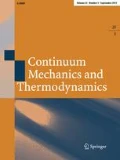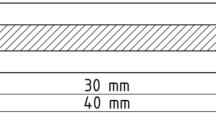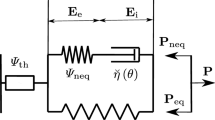Abstract
Especially in the automotive industries, elastomers take an important role. They are used in different types of bearings, where they inhibit vibration propagation and thereby significantly enhance driving performance and comfort. That is why several models have already been developed to simulate the material’s mechanical response to stresses and strains. In many cases, these models are developed under isothermal conditions. Others include the temperature-dependent mechanical behaviour to represent lower stiffness’s for higher temperatures. In this contribution it is shown by some exemplary experiments that viscoelastic material heats up under dynamic deformations. Hence, the material’s properties change due to the influence of the temperature without changing the surrounding conditions. With some of these experiments, it is shown that a fully coupled material model is necessary to predict the behaviour of bearings under dynamic loads. The focus of this contribution lies on the modelling of the thermoviscoelastic behaviour of elastomers. In a first step, a twofold multiplicative split of the deformation gradient is performed to be able to describe both mechanical and thermal deformations. This concept introduces different configurations. The stress tensors existing on these configurations are used to formulate the stress power in the first law of thermodynamics which allows to simulate the material’s self-heating. To formulate the temperature dependency of the mechanical behaviour, the non-equilibrium part of the Helmholtz free energy function is formulated as a function of the temperature and the deformation history. With the introduced model, some FE calculations are carried out to show the model’s capability to represent the thermoviscoelastic behaviour including the coupling in both directions.
Similar content being viewed by others
References
Alts T.: On the energy-elasticity of rubber-like materials. Prog. Coll. Pol. Sci. S 66, 367–375 (1979)
Amin A., Lion A., Sekita S., Okui Y.: Nonlinear dependence of viscosity in modeling the rate-dependent response of natural and high damping rubbers in compression and shear: experimental identification and numerical verification. Int. J. Plast. 22, 1610–1657 (2006)
Anand L., Ames N.M., Srivastava V., Chester S.A.: A thermo-mechanically coupled theory for large deformations of amorphous polymers. Part I: formulation. Int. J. Plast. 25, 1474–1494 (2009)
Arruda E.M., Boyce M.C.: A three-dimensional constitutive model for the large stretch behavior of rubber elastic materials. J. Mech. Phys. Solids 41, 389–412 (1993)
Chadwick P.: Thermo-mechanics of rubberlike materials. Philos. Trans. R. Soc. Lond. A 276, 371–403 (1974)
Cho H., Bartyczak S., Mock W., Boyce M.C.: Dissipation and resilience of elastomeric segmented copolymers under extreme strain rates. Polymer 54, 5952–5964 (2013)
Coleman B.D., Gurtin M.E.: Thermodynamics with internal variables. J. Chem. Phys. 47, 597–613 (1967)
Coleman B.D., Noll W.: The thermodynamics of elastic materials with heat conduction and viscosity. Arch. Rat. Mech. Anal. 13, 167–178 (1963)
Dargazany, R., Khîem, V.N., Itskov, M.: A generalized network decomposition model for the quasi-static inelastic behaviour of filled elastomers. Int. J. Plast. 63, 94–109 (2014)
Dippel, B.: Experimentelle Charakterisierung, Modellierung und FE-Berechnung thermomechanischer Kopplungen am Beispiel eines rußgefüllten Naturkautschuks. Ph.D. thesis. Universität der Bundeswehr München (2015)
Dippel, B., Johlitz, M., Lion, A.: Thermo-mechanical couplings in elastomers—experiments and modelling. Z. Angew. Math. Mech. doi:10.1002/zamm.201400110 (2014)
Ehlers W., Ellsiepen P.: PANDAS: Ein FE-System zur Simulation von Sonderproblemen der Bodenmechanik. In: Wriggers, P., Meißner, U., Stein, E., Wunderlich, W. (eds) Finite Elemente in der Baupraxis: Modellierung, Berechnung und Konstruktion, Beiträge zur Tagung FEM ’98 an der TU Darmstadt am 5. und 6. März 1998, pp. 431–400. Ernst & Sohn, Berlin (1998)
Göktepe S., Miehe C.: A micro-macro approach to rubber-like materials. Part III: The micro-sphere model of anisotropic Mullins-type damage. J. Mech. Phys. Solids 53, 2259–2283 (2005)
Haupt P.: Continuum Mechanics and Theory of Materials. Springer, Berlin (2000)
Haupt P., Lion A.: On finite linear viscoelasticity of incompressible isotropic materials. Acta Mech. 159, 87–124 (2002)
Haupt P., Tsakmakis C.: On the application of dual variables in continuum mechanics. Continuum Mech. Thermodyn. 1, 165–196 (1989)
Höfer P., Lion A.: Modelling of frequency- and amplitude-dependent material properties of filler-reinforced rubber. J. Mech. Phys. Solids 57, 500–520 (2009)
Horstemeyer M.F., Bammann D.J.: Historical review of internal state variable theory for inelasticity. Int. J. Plast. 26, 1310–1334 (2010)
Huber N., Tsakmakis C.: Finite deformation viscoelasticity laws. Mech. Mater. 32, 1–18 (2000)
Johlitz M., Scharding D., Diebels S., Retka J., Lion A.: Modelling of the thermo-viscoelastic material behaviour of polyurethane close to the glass transition temperature. Z. Angew. Math. Mech. 90, 387–398 (2009)
Kaliske M., Heinrich G.: An extended tube-model for rubber elasticity: statistical-mechanical theory and finite element implementation. Rubber Chem. Technol. 72, 602–632 (1999)
Keck, J.: Zur Beschreibung finiter Deformation von Polymeren, Experimente, Modellbildung, Parameteridentifikation und Finite-Elemente-Formulierung. Dissertation, Bericht-Nr. I-5 des Instituts für Mechanik (Bauwesen), Lehrstuhl I, Universität Stuttgart (1998)
Khan A.S., Lopez-Pamies O., Kazmi R.: Thermo-mechanical large deformation response and constitutive modeling of viscoelastic polymers over a wide range of strain rates and temperatures. Int. J. Plast. 22, 581–601 (2006)
Krempl E., Khan F.: Rate (time)-dependent deformation behaviour: an overview of some properties of metals and solid polymers. Int. J. Plast. 19, 1069–1095 (2003)
Lin R.C., Brocks W.: On a finite strain viscoplastic theory based on a new internal dissipation inequality. Int. J. Plast. 20, 1281–1311 (2004)
Lin R.C., Brocks W., Betten J.: On internal dissipation inequalities and finite strain inelastic constitutive laws: theoretical and numerical comparisons. Int. J. Plast. 22, 1825–1857 (2006)
Lion A.: A constitutive model for carbon black filled rubber, experimental results and mathematical representation. Continuum Mech. Thermodyn. 8, 153–169 (1996)
Lion A.: On the large deformation behaviour of reinforced rubber at different temperatures. J. Mech. Phys. Solids 45, 1805–1834 (1997)
Lion A.: A physically based method to represent the thermo-mechanical behaviour of elastomers. Acta Mech. 123, 1–25 (1997)
Lion, A.: Thermomechanik von Elastomeren. Berichte des Instituts für Mechanik der Universität Kassel (Bericht 1/2000) (2000)
Lion A., Dippel B., Liebl C.: Thermomechanical material modelling based on a hybrid free energy density depending on pressure, isochoric deformation and temperature. Int. J. Solids Struct. 51, 729–739 (2014)
Lion A., Kardelky C.: The payne effect in finite viscoelasticity: constitutive modelling based on fractional derivatives and intrinsic time scales. Int. J. Plast. 20, 1313–1345 (2004)
Lubliner J.: A model of rubber viscoelasticity. Mech. Res. Commun. 12, 93–99 (1985)
Miehe C., Göktepe S.: A micro-macro approach to rubber-like materials. Part II: the micro-sphere model of finite rubber viscoelasticity. J. Mech. Phys. Solids 53, 2231–2258 (2005)
Miehe C., Göktepe S., Lulei F.: A micro-macro approach to rubber-like materials. Part I: the non-affine micro-sphere model of rubber elasticity. J. Mech. Phys. Solids 52, 2617–2660 (2004)
Miehe C., Keck J.: Superimposed finite elastic–viscoelastic–plastoelastic stress response with damage in filled rubbery polymers. Experiments, modelling and algorithmic implementation. J. Mech. Phys. Solids 48, 323–365 (2000)
Mooney M.: A theory of large elastic deformation. J. Appl. Phys. 11, 582–592 (1940)
österlöf, R., Wentzel, H., Kari, L., Diercks, N., Wollscheid, D.: Constitutive modelling of the amplitude and frequency dependency of filled elastomers utilizing a modified Boundary Surface Model. Int.J. Solids. Struct. 51(19–20), 3431–3438 (2014)
Reese S.: A micromechanically motivated material model for the thermo-viscoelastic material behaviour of rubber-like polymers. Int. J. Plast. 19, 909–940 (2003)
Reese S., Govindjee S.: Theoretical and numerical aspects in the thermo-viscoelastic material behaviour of rubber-like polymers. Mech. Time Depend. Mater. 1, 357–396 (1998)
Reese S., Govindjee S.: A theory of finite viscoelasticity and numerical aspects. Int. J. Solids Struct. 35, 3455–3482 (1998)
Rendek M., Lion A.: Amplitude dependence of filler-reinforced rubber: experiments, constitutive modelling and fem – implementation. Int. J. Solids Struct. 47, 2918–2936 (2010)
Rodas C.O., Zaïri F., Naït-Abdelaziz M.: A finite strain thermo-viscoelastic constitutive model to describe the self-heating in elastomeric materials during low-cycle fatigue. J. Mech. Phys. Solids 64, 396–410 (2014)
Sedlan, K.: Viskoelastisches Materialverhalten von Elastomerwerkstoffen, Experimentelle Untersuchung und Modellbildung. Dissertation, Berichte des Instituts für Mechanik (2/2001), Universität Gesamthochschule Kassel (2001)
Shutov A., Landgraf R., Ihlemann J.: An explicit solution for implicit time stepping in multiplicative finite strain viscoelasticity. Comput. Methods Appl. Mech. Eng. 265, 213–225 (2013)
Simo J.C., Taylor R.L.: Penalty function formulations for incompressible nonlinear elastostatics. Comput. Meth. Appl. Mech. Eng. 35, 107–118 (1982)
Treloar, L.: The Physics of Rubber Elasticity, 3rd edn. Clarendon Press Oxford (1975)
Vandenbroucke A., Laurent H., Hocine N.A., Rio G.: A hyperelastic-visco-hysteresis model for an elastomeric behaviour: experimental and numerical investigations. Comput. Mater. Sci. 48, 495–503 (2010)
Williams M.L., Landel R.F., Ferry J.D.: The temperature dependence of relaxation mechanisms in amorphous polymers and other glass-forming liquids. J. Am. Chem. Soc. 77, 3701–3707 (1955)
Wollscheid D., Lion A.: Predeformation- and frequency-dependent material behaviour of filler-reinforced rubber: experiments, constitutive modelling and parameter identification. Int. J. Solids Struct. 50, 1217–1225 (2013)
Author information
Authors and Affiliations
Corresponding author
Additional information
Communicated by Andreas Öchsner.
Rights and permissions
About this article
Cite this article
Johlitz, M., Dippel, B. & Lion, A. Dissipative heating of elastomers: a new modelling approach based on finite and coupled thermomechanics. Continuum Mech. Thermodyn. 28, 1111–1125 (2016). https://doi.org/10.1007/s00161-015-0469-7
Received:
Accepted:
Published:
Issue Date:
DOI: https://doi.org/10.1007/s00161-015-0469-7




